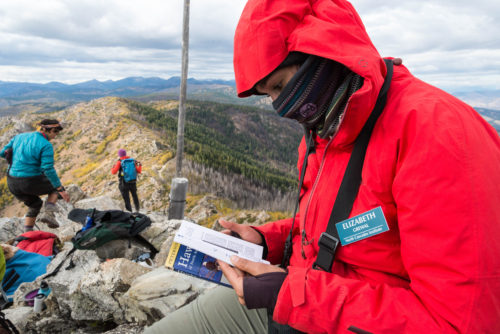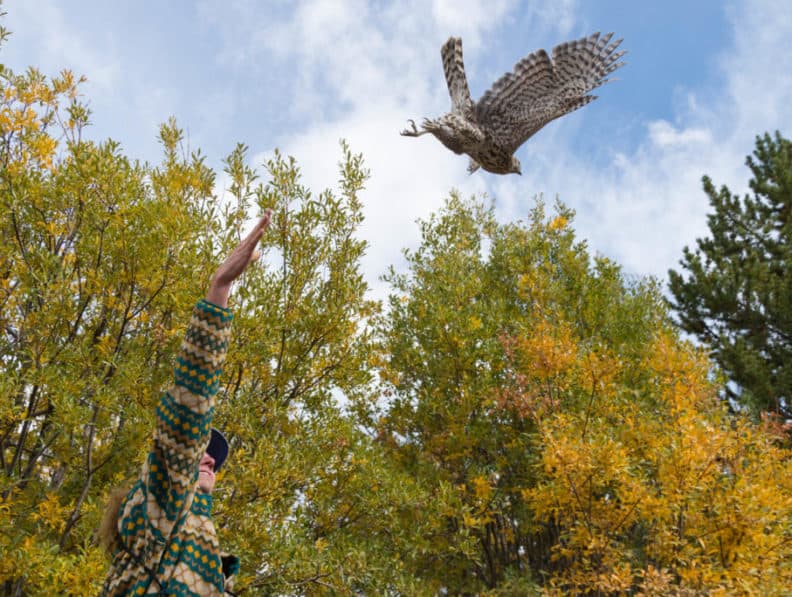
Natural History Field-Excursion: Migrating Raptors over Chelan Ridge
This post is the first of a 3-part series describing graduate students’ ten-day field excursion to the Methow Valley, as part of their fall Natural History Course. Below is writing by Brendan McGarry, graduate student in the North Cascade Institute’s 17th cohort.
The first thing I saw when I opened my eyes was frost coating the inside of the rainfly. I could hear the crepuscular stirrings of my fellow campers, and gave myself a silent pep talk to get moving despite the chill. This was going to be an exciting day after all, we were here to see raptors.
My cohort and I were part way through the field section of our Natural History of the North Cascades course when we trundled up to Chelan Ridge Hawkwatch Station. It was only October, but we’d seen the hints of winter coming to the high places. The hawks we hoped to see migrating were another hint that the seasons were changing.
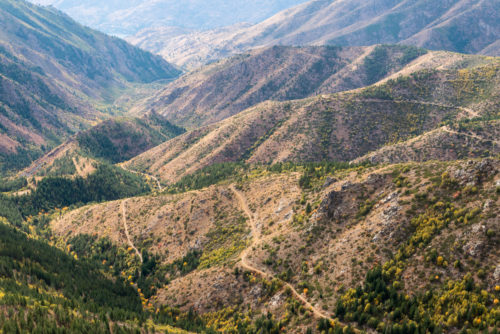
The rugged terrain stretching down toward Lake Chelan; photo courtesy of Brendan McGarry
The Chelan Ridge Hawkwatch station was established in 1998 in a partnership between the Okanogan-Wenatchee District of the US Forest Service and HawkWatch International. The goal was to learn more about the raptors migrating through Washington, down the Pacific Coast Flyway. Here, starting in late August, ending in late October, intrepid biologists scan the skies, and count hawks. With luck, they also lure them into traps to band the birds and release. While we were grumbling about the cold, they were already out doing their jobs.
The first bird, an immature Cooper’s Hawk that zipped by during breakfast, was spotted by Kent Woodruff. This was apt because he was our host. Kent, a retired Forest Service biologist who established the station, was full of stories about the wildlife of the North Cascades. Yet, never was he more animated than when he spoke of the birds overhead.
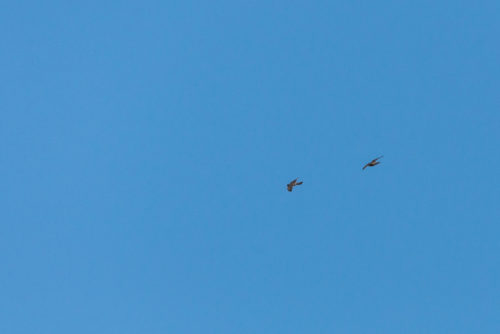
Two Merlins (Falco columarius) chasing each other over the ridge
The wind was blowing out of the North, not good for a productive day. Kent was convinced it would be a low count, but still gave us a passionate rundown of why they band and count birds of prey. Their goal was to understand the pulse of raptor populations, while also gaining tidbits to further refine our understanding of their life histories. Mortality was the rule for the young birds, most wouldn’t make the journey back North. This was a hard game, and we’d see many more youngsters than adults.
Perched on a rock between the main count station and the trapping station, Kent set us up to count. Our location gave us vantage of a huge swath of the Cascade Range, down through the Columbia River gorge, and East into the Waterville Plateau. Despite the conditions, we seemed perfectly positioned to spot birds the other observers missed. By noon we’d seen ten species of raptors, more than half the species counted in a season.
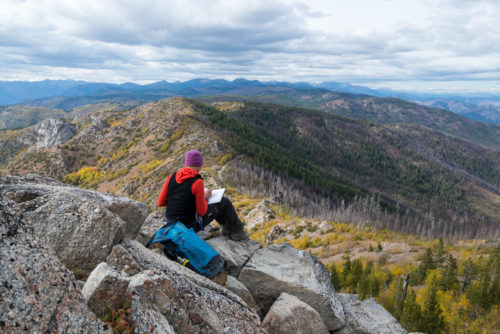
Zoe Wadkins admiring the Sawtooth Range as seen from the HawkWatch Station
Liz Grewal reading about hawks at the observation station
In truth, the activity was nothing short of spectacular. In a couple hours we’d spotted the season’s first Rough-legged Hawk, contrasting with a very late Osprey, an early season bird. We’d witnessed the aerial prowess of Merlins, as two of these small falcons played high-speed chase over the ridge. More common hawks were frequent, but these Red-tailed, Cooper’s, and Sharp-shinned Hawks were all opportunities to sharpen our skills as novice hawk watchers. All the while we could hear the chips of Yellow-rumped Warblers, “the krill of the forest,” also migrating, and deeply important food for many of these raptors. Getting the opportunity to see birds in migration was one thing. Getting to see them up close, in hand, was another altogether. Kent got word that the trapping station had caught a Sharp-shinned Hawk and rushed off to bring it back for a closer look. The bird was a big, fat, and healthy immature female. After admiring the anatomy that kept her afloat, we released her to continue on.
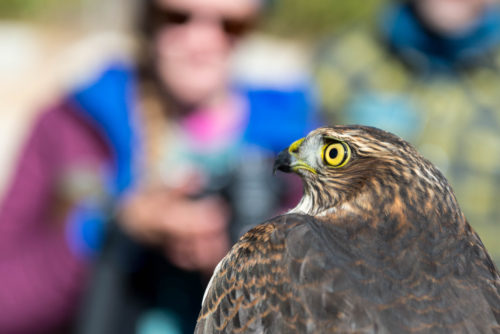
The Sharp-shinned Hawk caught by the banding station
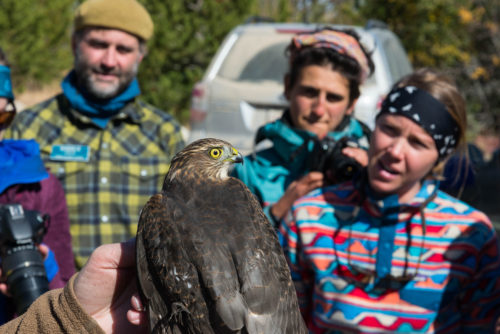
The cohort admires the Sharp-shinned Hawk caught by the banding station
Moments later, a Northern Goshawk – the larger cousin of the Sharp-shinned Hawk – was also caught. Kent zipped off again, and returned with a hefty, vocal, immature male. If he was lucky, he’d become the kind of predator that could take down birds nearly his size. He showed potential as he shot off when released, stopping to readjust his feathers before ghosting into the thick lodgepole pine atop the ridge.With the small aluminum bands these birds carried, there’s an opportunity to know more about the hawks in our region. Recapture or recovery of a band is uncommon, but such data is worth the trouble because it can provide information that would be impossible to obtain otherwise. Kent made it clear banding was risky, but knowing as much as possible about a species increases the potential for their survival. Ultimately, Chelan Ridge and stations like it are concerned about the health and movements of raptor populations, because the birds are keystones to healthy ecosystems worldwide.
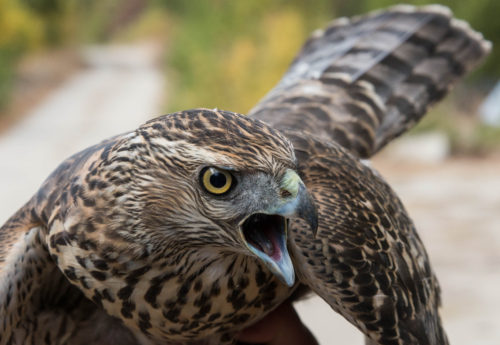
The Northern Goshawk caught by the banding station, showing his discontent just before release
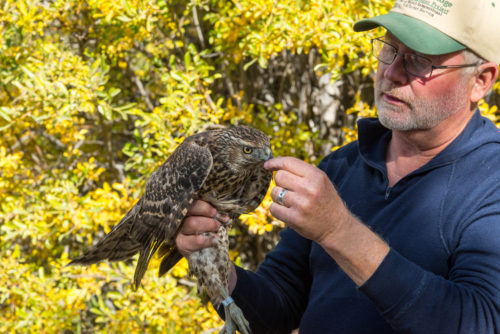
Kent Woodruff showing the cohort the Northern Goshawk caught by the banding station
By visiting Chelan Ridge, my cohort and I broadened our understanding of what the North Cascades represented. Many organisms call it home, but we now see it as vital land linking the Pacific Coast Flyway. Gaining a 100 mile view of the natural history of a region takes many years of study. We all felt very lucky to have just a 1 mile view, especially with these spectacular birds crossing through.
All photos are courtesy of Brendan McGarry. To see more of his work, visit WingTrip.org.


